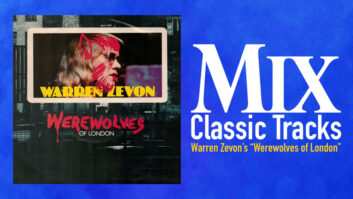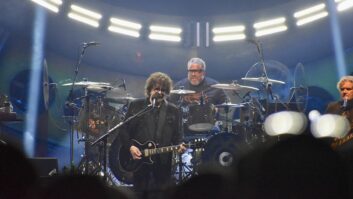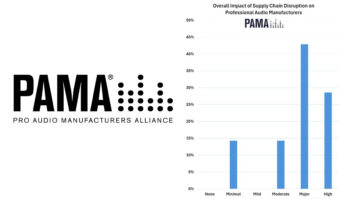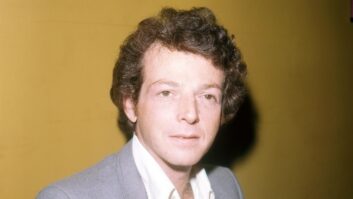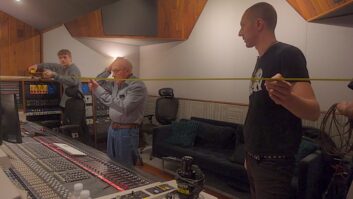During the course of one week in the late summer of 1971, the Nitty Gritty Dirt Band and a who’s who of Nashville’s greatest pickers and singers made one of the finest and most important recordings to emerge from that city in a generation. Earl Scruggs, Doc Watson, Merle Travis, Mother Maybelle Carter, Roy Acuff, Jimmy Martin and Vassar Clements had all agreed to make a record with what Acuff called “a bunch of longhaired West Coast boys.” It seemed a long shot according to Mike Stewart, president of United Artists at the time, but he approved a $22,000 budget because bandmember John McEuen and his producer brother, Bill, were so intent on making it happen. What emerged from those sessions was nothing short of amazing — impeccable musicianship and singing recorded without overdubbing straight to a 2-track analog machine running at 30 ips. Will the Circle Be Unbroken was released as a three-LP set containing 33 tracks 30 years ago, and it went on to sell well over 1.5 million copies. For many bluegrass and acoustic music fans, the Circle album, as it became known, was a mandatory addition to their record collection; it seems everybody knew this record.
And they still do. When I picked up a copy of Billboard today (in mid-May), that same recording had climbed 12 places on the Country Catalog chart to Number 3. And yesterday, I received a phone call from John McEuen, who was in a Nashville studio recording Circle III with the likes of Johnny Cash and Taj Mahal. In a world of overproduced country crossover/pop music releases from the same small group of major country stars, it is encouraging to know that simple, heartfelt music can still resonate with the public. The phenomenal success of the soundtrack to the movie O Brother, Where Art Thou? may not be an aberration after all.
I first met John McEuen, the banjo picker for the Dirt Band, in the summer of 1980 in Aspen, Colo. While making a cross-country trip with the late Mike Denecke — audio guru and inventor of the ubiquitous timecode slate and myriad other neat devices for film audio — we stopped for a couple of days to visit the band and see a concert. Mike had spent a lot of time working at Bill McEuen’s Aspen-based recording studio, home of the Aspen Recording Society, his production entity. It was during this time that I learned about some of the technical details of the original Circle recording sessions held at Woodland Sound Studios in Nashville way back in 1971. Partly for aesthetic reasons and partly due to the extremely limited recording budget, Bill and engineer Dino Lappas decided to capture the ensemble straight-to-tape. Most contemporary recordings were being tracked on 24-track 2-inch machines, loaded with overdubs and subsequently mixed to 2-track masters. Their decision to produce the Circle album this way is one of the factors that makes this recording timeless. Although it sometimes took several takes to get it exactly right, the 33 tunes are simple and elegant sonic documents full of dynamic range and acoustic richness — perfect candidates for recapturing and remastering using new high-resolution digital tools.
I have been a musician and audio engineer for more than 20 years. Pacific Coast Sound Works, which I founded in 1989 with a pre-release version of Sonic Solutions’ first CD pre-mastering system, became AIX Media Group in 1994. We’ve produced a large number of enhanced CDs for groups as divergent as the Rolling Stones, Yanni, and, most recently, 311 and the Henry Rollins Band. Equipped with some early DVD production tools, AIX entered the “authoring and compression” business back in 1996 and actually produced the very first DVD-Video titles in March of the following year. The DVD business became the fastest-growing new consumer electronics format in history by bringing Hollywood into the digital age — the days of VHS tape are numbered, thanks to the movie version of a 12cm disc.
But DVD-Video is a format primarily concerned with delivering blockbuster movies to the world’s home theaters. Most music DVDs, while successful and engaging (we just finished mastering and producing the new Bad Company DVD titled Merchants of Cool) haven’t yet elevated the quality of the audio experience; they’re basically concerts with better video and 5.1 surround mixes encoded using “lossy” music compression schemes. With the arrival of the DVD-Audio format, the recording industry will finally get its shot at developing content with music as the central media component. AIX is actively creating products for its own label and others in this format — perhaps the Circle could be reborn at 96 kHz/24 bits.
John and I approached Capitol/EMI about licensing the 2-track master for release as a DVD-Audio product. Unfortunately, the request was denied. It seems that the Nashville arm of Capitol/EMI, headed by Mike Dungan (a huge fan of the Circle record), had plans for a 30th anniversary reissue on compact disc. John was enlisted to produce the reissue CD, and both he and the record company agreed that AIX and I should handle the transfers and digital remastering. The little-known fact that made the prospect of working on this product all the more exciting was that the original master recordings and outtakes were stored all these years by Bill McEuen, apart from the company vault. The record company has been making CDs from the 15 ips safety copies since the first CD version of the Circle was made available more than 15 years ago. What a treat it would be to actually work from the source masters — unprocessed, un-EQ’d and with all the warmth that can be captured using 30 ips 2-track equipment.
Step one was to locate the tapes amid all of the other boxes and paraphernalia in a storage unit out in Ventura, Calif. — a job that required flying Bill’s wife Alice (the person responsible for the handwriting on the cover of the album) in from their new home in Hawaii. After several attempts to locate the box of masters, John and Alice were successful. The original master tapes and all of the outtakes were soon to be played again after 30 years!
As a recording and mastering engineer with more years of experience than I care to admit to, I’ve been confronted with many challenges when unearthing tapes that have been stored for any substantial amount of time. Most of us doing this kind of work are familiar with splices drying out and breaking during playback or, worse yet, during rewind or fast forward. Baking tapes of a certain vintage before playback is a commonplace technique for restoring playability to old masters, but the Circle masters required only a few new splices and didn’t exhibit any of the problems associated with loss of lubricants or shedding. Bill and John were extremely surprised to learn that the masters were intact and ready to be transferred into our Sonic Solutions HD system.
The plan was to capture all 27 tapes using the highest-resolution A/D conversion equipment we could find. I figured if we were going to play every tape into my high-resolution Sonic HD system, then it should be done at the highest sampling rate and word size — who knows where these tapes might eventually end up? Now, I’m very familiar with most of the current crop of high-end converters, because my fledgling record company, AIX Records, is recording, mixing and mastering music produced specifically for the DVD-Audio format. In order to accomplish the kind of work that we’re doing, we installed an R-1 digital multitrack and digital console, both manufactured by Euphonix. We’ve done many hours of critical listening and have been very pleased with the outboard converters feeding the R-1. I’ve also used A/D equipment from dB Technologies and DCS with great results, but it was the newest Pacific Microsonics HDCD (now handled by Euphonix) and Genex converters capable of running at 192 kHz/24 bits that intrigued me the most.
I make multitrack recordings using multiple pairs of stereo mics. When producing a new set of tracks, I know that I’m going to be delivering my mixes on a DVD-Audio disc into multiple 5.1-channel surround sound mixes (“stage” vs. “audience”) and in PCM stereo. One of our recent AIX releases, Nitty Gritty Surround with John and former bandmate Jimmy Ibbotson (along with Jennifer Warnes and the String Wizards), is essentially a 21st-century incarnation of the original Circle. One day before a show that they were doing in Hanford, Calif., we trucked our R-1 recorder and a slew of microphones and stereo bars to the Fox Theater to capture the musicians at 96 kHz/24 bits, while they performed live, arranged in a circle. The results of that long day can be experienced in DVD-Audio and DVD-Video, both on the same disc but on opposite sides (check out www.aixrecords.com). The highest fidelity available using state-of-the-art tools and techniques can be fully appreciated because we used 96 kHz/24 bits with performing musicians. (Most new DVD-Audio releases are remixed into 5.1-channel surround from older analog tapes. Even if they’re captured at 96 kHz/24 bits, they still have the dynamic range of the original recording.)
Using MLP (Meridian Lossless Packing), the standard algorithm for the DVD format, the highest sampling rate is restricted to 96 kHz/24 bits. My experience with 192kHz/24-bit converters has therefore been somewhat limited, although I have evaluated DCS equipment. But because the Circle tapes were recorded in stereo, it was worth trying the highest available sampling rate. We rented the gear from DMT, a local high-end digital equipment company, and started sorting out the interconnections late one Friday afternoon. After many hours of making digital connections, trying all of the clocking options available on the Sonic I/O panel, and making repeated phone calls to tech support, several test recordings were accomplished. In the end, we opted for the lower sampling rate (96 kHz/24 bits) on a dB Technologies box. It’s not that the HDCD or Genex equipment didn’t work or even sound warm and transparent; they did. But with limited access to the equipment, we knew we wouldn’t be able to play back the recordings as needed over the coming weeks. Finally, the increase in fidelity with 30-year-old tapes didn’t warrant the additional expense of the rentals.
Bright and early Saturday morning, I set about transferring all of the masters, including the outtake reels. If you’re at all familiar with the Circle record, you know that there are a lot of conversations left on the final release. The outtakes contain many great moments, too, and they were all run through our ATR-100 and captured at 96 kHz/24 bits and 44.1/16 bits. Yes, I did all of the transfers twice. Mike Dungan and Capitol wanted to make a compact disc, but John and I wanted to archive these recordings at high resolution and someday hope to release the “audiophile edition” on DVD-Audio. So, rather than suffer the sonic degradation of sample rate converting from 96 to 44.1, I churned through the master reels and outtakes over the course of the next several days. John spent the time logging a variety of new “conversational” gems for the reissued CD and searching for a couple of new music tracks to include in the package. I simply kept my alignment tape, head-cleaning solution and chamois swabs handy while I thoroughly enjoyed eavesdropping on the sessions held 30 years ago.
We purchased a copy of the Circle CD at a local Borders for comparison, and to make sure that we were addressing the same track numbers as the original. We felt the sound of the compact disc version was dull and lacked low end. After spending the weekend listening to the masters, this wasn’t a big surprise. But what did startle us was the fact that the left and right channels were reversed from the master tapes! After numerous checks and rechecks, we determined that we had to switch the left and right for the reissue. What you will hear on the new version returns the stereo assignments back to their original positions. It’s hard to fathom just how that fact was missed for almost 15 years, but it was.
The final stage in the process was to balance the levels and apply equalization where required. It turned out that we had to do very little in the area of dynamic compensation — these tracks come alive because they weren’t heavily compressed or homogenized for radio play. It’s immediately apparent that Bill and Dino were trying to make a very high-fidelity “sonic documentary” of an extraordinary gathering of musicians, rather than feed the traditional recording industry model, which is to make tracks that pierce the speakers on your playback system! As for EQ, the low end proved to be the most problematic. At first, we thought this was the result of the 30 ips recording speed, but John remembered that the studio door was left open during much of the recording, which resulted in a balance problem in the bass. We cleared that up with some low-frequency shelving EQ. Then we inserted the bonus materials that we edited out of the new transfers and sent off reference copies to the record company back in Nashville.
The reaction was immediate and extremely positive. And the response by music consumers has been equally heartening. Apparently, the art of recording, as shown by these 30-year-old tracks, hasn’t advanced as far as we would like to think. Just imagine the sound of world-class musicians playing live in front of a bunch microphones in a studio, and that is exactly what you will hear in the remastered version of the Circle album. All of the warmth, dynamic range, fidelity and “you-are-there” sonic reality comes through like never before. There are undoubtedly lessons to be learned from these old tracks — it will interesting to see whether the record industry pays attention.

